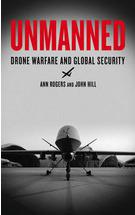 As writers and analysts for one of the military’s key journals - Jane’s Intelligence Review - Ann Rogers and John Hill have respectable military credentials. Nevertheless much of the analysis in this important and engaging overview of the drone wars could easily grace the pages of Peace News.
As writers and analysts for one of the military’s key journals - Jane’s Intelligence Review - Ann Rogers and John Hill have respectable military credentials. Nevertheless much of the analysis in this important and engaging overview of the drone wars could easily grace the pages of Peace News.
Chapter by chapter the book investigates the key aspects of the use of armed drones, including tracing their history, the effect on military doctrine, ethical and legal issues, the impact on the ground and the push towards greater autonomy.
Drones, the book contends are helping to normalise the use of states' 'targeting individuals with military-scale force' and blurring the lines between law enforcement and military action giving rise to what the authors call _nano-wars_. They state: 'The serious battering of just war conventions by US drone strikes contributes to a new set of norms that are likely to be regressive to the causes of peace and international stability.'
They argue that in certain cases just because drones can be used to target individuals, they are being used whether this is effective in achieving the overall goals of creating security or not. In fact, the authors argue, in Pakistan and Yemen not only are the strikes failing to isolate the insurgency from the population, they are antagonising populations and radicalising the 'pre-insurgent' - and it is perhaps the US who is becoming increasing isolated from the international community over the strikes.
The authors clearly have some sympathy for the drone pilots arguing that when not being 'bored to death' by watching hours of mind-numbing footage and castigated by their colleagues for merely being a 'chair force' they also have to make life and death decisions which take a toll on their mental well-being. While some accounts from drone pilots are beginning to leak out, the reality of the drone wars from the perspective of the drone pilot is still to be voiced.
The authors say that they want to investigate the consequences of the use of armed drones not just on the battlefield but also on human society as a whole, using the theories of Marshal McLuhan. This would have made a valuable contribution to the growing literature on the use of drones and I would have liked to have seen much more of it in the book.
They conclude that, in McLuhan’s terms, the message of this new medium is that the drone gives the 'capacity to intervene overseas with impunity to today’s powers.' The question they ask is whether this is desirable in terms of global security. The authors, and I’m sure PN readers would agree, is that it is not.


